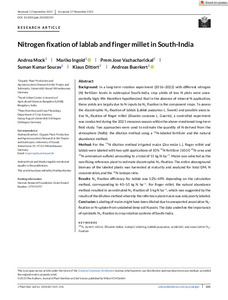| dc.date.accessioned | 2024-04-08T13:43:32Z | |
| dc.date.available | 2024-04-08T13:43:32Z | |
| dc.date.issued | 2023-12-21 | |
| dc.identifier | doi:10.17170/kobra-202404049896 | |
| dc.identifier.uri | http://hdl.handle.net/123456789/15634 | |
| dc.description.sponsorship | Gefördert im Rahmen des Projekts DEAL | ger |
| dc.description.sponsorship | German Research Foundation | eng |
| dc.language.iso | eng | |
| dc.rights | Namensnennung 4.0 International | * |
| dc.rights.uri | http://creativecommons.org/licenses/by/4.0/ | * |
| dc.subject | ¹⁵N | eng |
| dc.subject | dystric nitisol | eng |
| dc.subject | Eleusine indica | eng |
| dc.subject | isotopic labeling | eng |
| dc.subject | Lablab purpureus | eng |
| dc.subject | symbiotic and associative N₂-fixation | eng |
| dc.subject.ddc | 580 | |
| dc.title | Nitrogen fixation of lablab and finger millet in South-India | eng |
| dc.type | Aufsatz | |
| dcterms.abstract | Background
In a long-term rotation experiment (2016–2022) with different nitrogen (N) fertilizer levels in subtropical South-India, crop yields of low N plots were unexpectedly high. We therefore hypothesized that in the absence of mineral N application, these yields are largely due to N inputs by N₂ fixation in the component crops. To assess the diazotrophic N₂-fixation of lablab (Lablab purpureus L. Sweet) and possible associative N₂-fixation of finger millet (Eleusine coracana L. Gaertn), a controlled experiment was conducted during the 2021 monsoon season within the above-mentioned long-term field study. Two approaches were used to estimate the quantity of N derived from the atmosphere (Ndfa): the dilution method using a 15N-labeled fertilizer and the natural abundance method.
Method
For the ¹⁵N dilution method irrigated maize (Zea maize L.), finger millet and lablab were labeled with two split applications of 10% 1¹⁵N fertilizer (50:50 ¹⁵N-urea and ¹⁵N-ammonium sulfate) amounting to a total of 15 kg N ha−1. Maize was selected as the non-fixing reference plant to estimate diazotrophic N₂-fixation. The entire aboveground biomass of the labeled plants was harvested at maturity and analyzed for total DM, N concentration, and the ¹⁵N isotope ratio.
Results
N₂ fixation efficiency for lablab was 52%–69% depending on the calculation method, corresponding to 40–53 kg N ha−1. For finger millet, the natural abundance method resulted in an estimated N2-fixation of 5 kg N ha−1, which was suggested by the results of the dilution method whereby the reference plant maize was only poorly labeled.
Conclusion
Labeling of maize might have been diluted due to unexpected associative N₂-fixation or N-uptake from unlabeled deep soil N pools. The data underline the importance of symbiotic N₂-fixation in crop rotation systems of South-India. | eng |
| dcterms.accessRights | open access | |
| dcterms.creator | Mock, Andrea | |
| dcterms.creator | Ingold, Mariko | |
| dcterms.creator | Vazhacharickal, Prem Jose | |
| dcterms.creator | Sourav, Suman Kumar | |
| dcterms.creator | Dittert, Klaus | |
| dcterms.creator | Bürkert, Andreas | |
| dc.relation.doi | doi:10.1002/jpln.202300319 | |
| dc.relation.projectid | Grant Number: 279374797 | |
| dc.subject.swd | Indien (Süd) | ger |
| dc.subject.swd | Stickstofffixierung | ger |
| dc.subject.swd | Fingergras | ger |
| dc.subject.swd | Helmbohne | ger |
| dc.type.version | publishedVersion | |
| dcterms.source.identifier | eissn:1522-2624 | |
| dcterms.source.issue | Issue 2 | |
| dcterms.source.journal | Journal of Plant Nutrition and Soil Science | eng |
| dcterms.source.pageinfo | 225-232 | |
| dcterms.source.volume | Volume 187 | |
| kup.iskup | false | |


